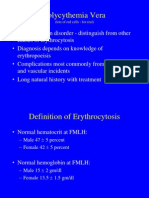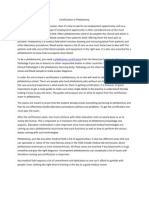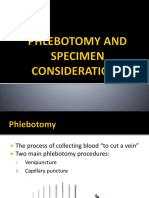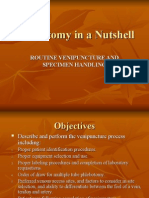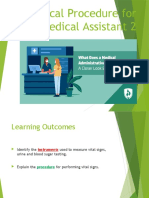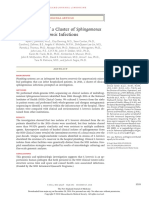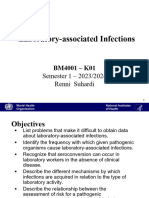Policy Phlebotomy Blood Collection
Policy Phlebotomy Blood Collection
Uploaded by
muhammadhanifmohdfahmiCopyright:
Available Formats
Policy Phlebotomy Blood Collection
Policy Phlebotomy Blood Collection
Uploaded by
muhammadhanifmohdfahmiOriginal Description:
Copyright
Available Formats
Share this document
Did you find this document useful?
Is this content inappropriate?
Copyright:
Available Formats
Policy Phlebotomy Blood Collection
Policy Phlebotomy Blood Collection
Uploaded by
muhammadhanifmohdfahmiCopyright:
Available Formats
BD Global Public Policy Position
Improving Phlebotomy and Blood Collection Practices
ISSUE: Poor phlebotomy and blood collection practices adversely affect patient outcomes, place healthcare
workers at risk, and waste public health resources.
POSITION: BD supports regulatory and public policy frameworks that promote safe and high-
quality specimen collection practices. The following key elements should be included
in a comprehensive approach to advance proper specimen collection.
1. Professional councils dedicated to phlebotomy should be developed. Alternatively,
phlebotomy should be designated as an area of responsibility for existing professional councils.
Professional councils play a critical role in healthcare systems by developing training curriculum
and certification standards through expert, collaborative and transparent processes. These
councils also provide continuing education and professional development throughout a
healthcare workers career. Currently, there are few professional councils that are either
dedicated to phlebotomy or have phlebotomy as an area of responsibility. This gap is an
impediment to ensuring high quality and safe blood collection practices.
Training curriculum and certification standards should be established by professional councils
with a responsibility for phlebotomy. In the absence of a dedicated phlebotomy council,
government policy should promote inclusion of phlebotomy within the mandate of existing
medical technology councils.
2. Phlebotomy should be recognized as a distinct and critical discipline in healthcare delivery,
accompanied by training requirements with proficiency standards, certification, and oversight.
Training criteria and proficiency standards are essential to ensure that healthcare personnel
`engaged in phlebotomy, whether as their primary function or among their duties, have an
acceptable minimal level of training and demonstrated competency. Countries should establish
national policies that require mandatory training and proficiency assessment through
certification for healthcare personnel who draw blood specimens from patients. As healthcare
systems develop, licensing of personnel engaged in phlebotomy should also be a national goal.
Phlebotomy should be recognized in occupational standards as a distinct discipline within allied
health sciences. Academic curricula and employment pathways (including job descriptions)
should align with these occupational standards to reinforce the practice of phlebotomy as a
distinct discipline.
Improving Phlebotomy and Blood Collection Practices Page 1
for Better Health Outcomes, Efficiency and Safety
3. Governments should develop and implement enforceable national or regional guidelines on
specimen collection.
Guidelines are a critical tool in ensuring that best practices are disseminated.
They should be developed in a consultative process that engages all key stakeholders.
Governments should actively promote guideline development, implementation, and
enforcement to ensure the safety of patients and healthcare workers, as well as the fiscally
responsible utilization of resources.
4. Quality systems should be developed and maintained to ensure the training of personnel and
adherence to best practices in specimen sampling, based on established guidelines.
Quality systems are critical to ensure that training and adherence to best practice, based on
established guidelines, are sustained and integrated into laboratory operations. Regulatory and
accrediting bodies should require the institutions that they regulate to develop and maintain
such systems.
5. Recording and reporting of key adverse events is important and should include both the
incidence of preanalytical errors that result in specimen rejection or compromised care and the
incidence of needle stick injuries during blood collection.
Accurate measurement of errors is essential to improving outcomes and ensuring the safety,
quality, and efficiency of specimen collection and testing. Mandatory recording and reporting is
the most reliable mechanism to ensure accurate measurement of incidents. In the absence of
mandatory reporting, well-designed pilot programs in reporting management that are
benchmarked and demonstrate enhanced outcomes should be required and funded.
6. Medical technologies for strengthening phlebotomy practice specifically, improving overall
quality and efficiency of specimen collection and testing, and improving healthcare worker
safety, should be evaluated for implementation.
Technology plays an important role in reducing errors in sample collection and preparation,
and in reducing risks to healthcare worker safety. Such technologies should be evaluated
for implementation.
Given their essential role in specimen collection, healthcare workers should be included in
the evaluation process.
Background
Phlebotomy Plays a Critical Role in Healthcare Delivery and Patient Care
Phlebotomy, which is the science of drawing blood, is among the most common procedures in healthcare and a
core component of diagnosis and laboratory analysis. Estimates indicate that nearly 70% of medical decisions
Improving Phlebotomy and Blood Collection Practices Page 2
for Better Health Outcomes, Efficiency and Safety
are based on laboratory results which often rely on phlebotomy to produce a blood sample ready for laboratory
analysis1.
Despite the critical role of phlebotomy, there is often a lack of adequate priority and resources to ensure that
healthcare workers who engage in phlebotomy are properly trained on best practice, are aware of and adhere
to guidelines, and understand the consequences to patients and their own safety from improper sample
collection practices. In many settings, there are few or no training opportunities for healthcare workers who
draw blood. Additionally, in many countries there is a lack of strong national guidelines; or guidelines may exist,
but there is an insufficient level of awareness, training, and enforcement. In emerging economies where
healthcare systems are growing at a rapid pace, it is particularly important to develop policies and programs to
support best practice in sample collection.
Poor Blood Collection Practices Introduce Serious Errors into Diagnosis and Laboratory Analysis
Studies indicate that more than 50% of diagnostic errors are attributed to the poor collection and preparation of
samples, steps that occur before any laboratory test is undertaken (i.e., in the pre-analytical phase).2,3,4,5 These
errors are often the result of poor phlebotomy practices and they place patients at risk of receiving inaccurate
diagnoses, which can lead to inadequate, incorrect, or unnecessary treatment. An estimated 26% of these pre-
analytical errors have a significant effect on patient outcomes.6
Common pre-analytical errors introduced by poor phlebotomy practices
Hemolysis is the breakage of the red blood cells membranes, causing the release of
the hemoglobin and other internal components into the surrounding fluid. It can be
Hemolysis
due to pathological conditions in a patient, but is often due to improper specimen
collection, processing, or transport.
A sample can be contaminated due to improper site preparation, improper handling of
Contamination
equipment including washed vials and tubes, and errors in sample preparation.
Insufficient sample Improper techniques in drawing blood can result in an insufficient volume being
volume collected to support analysis.
Inaccurate labeling Errors in labeling can result in improper test and /or patient identification.
Spillage can occur during manual transfer of blood to vials or during specimen
Spillage
transportation in loosely sealed containers.
The formation of fibrin clots in blood collection containers can interfere with tests and
Fibrin clots can cause analyzer malfunction over time. Causes include errors in the preparation of
additives, mixing or transfer time.
Errors Introduced by Poor Phlebotomy Practices Can Harm Patients and Waste Public Health Resources
Compromised samples must be recollected to ensure accuracy of laboratory results and optimal patient care.
Consequently, specimen recollection often leads to delayed treatment, which can be particularly harmful for
patients in intensive care or emergency rooms. If compromised specimens are not recollected, errors can be
made in testing of these samples which can lead to incorrect clinical decisions, thus putting patients at risk for
inadequate, incorrect, or unnecessary procedures. For outpatients, repeated tests require another visit to the
clinic, with added inconvenience and costs for travel and potential out-of-pocket expenses.
Improving Phlebotomy and Blood Collection Practices Page 3
for Better Health Outcomes, Efficiency and Safety
At the health system level, blood collection errors impose real costs. Studies indicate that blood culture
contamination can result in unnecessary antibiotic administration, additional laboratory costs and increased
hospital lengths of stay.1 Such errors waste scarce healthcare resources due to repeat of laboratory tests,
unnecessary tests and procedures, and complications that result from inadequate and delayed treatments.7,8
This can also adversely affect the publics confidence in healthcare systems.
Poor Phlebotomy Practices Present Risks to Healthcare Worker Safety
Poor and unsafe phlebotomy practices also place healthcare workers at risk due to exposure to blood-borne
pathogens from needlestick injuries2. Such exposures increase risk of transmitting serious infectious diseases
such as hepatitis B, hepatitis C, HIV, malaria, and dengue9,10. When inappropriate phlebotomy practices result
in needlestick injuries, healthcare workers can face severe stress as they await test results to determine if they
have been infected11, and they may require post-exposure prophylaxis that can be expensive and have
debilitating side-effects, resulting in absenteeism and additional costs12.
Common Examples of Poor Phlebotomy Practices
WHO has highlighted several common examples of poor phlebotomy practices that can both compromise the
validity of the test result and also pose significant risks to the safety of healthcare workers13. These include:
Pressing the syringe plunger to force the blood into a tube which should be avoided because it
creates a level of pressure that can damage red blood cells in the sample
Using a needle to manually transfer blood into a tube which can cause accidental needlestick
injuries to healthcare workers and damage the sample
Underfilling or overfilling the sample tube resulting in improper ratio of blood to coagulant which
can compromise the sample
Re-using tubes that were not properly cleaned and disinfected which can cause infection
Unsafe collection and disposal of syringes and needles which can result in accidental needlestick
injury
These are but a few of the most commonly cited poor phlebotomy practices that can introduce significant risks
to patients and healthcare workers.
Large Variations Exist in Phlebotomy Practices and Training
Phlebotomy practices vary greatly among healthcare personnel, between countries and between institutions
and individuals within the same country. These differences include variation in blood-sampling technique,
training, use of safety devices, disposal methods, and reuse of devices.14,15,16 In many countries, there is either
no formal training, or a very low level of formal training for those who practice phlebotomy, which puts both
patients and healthcare workers at heightened risk of errors and injuries.
Improving Phlebotomy: Guidelines, Training, Performance-Based Certification, and Quality Systems
Achieving best practice in phlebotomy is critical to enhancing patient outcomes, improving health system
efficiency and protecting healthcare worker safety all of which are important to the sustainable management
of high quality healthcare systems worldwide. To accomplish this, several key elements should be in place:
1
Studies have shown lengths of stay increasing by several days due to these errors.
2
Phlebotomy involves the use of large, hollow needles that have been in a blood vessel. These needles can carry a large
volume of blood that, in the event of an accidental puncture, may expose healthcare workers to blood-borne exposures.
Improving Phlebotomy and Blood Collection Practices Page 4
for Better Health Outcomes, Efficiency and Safety
Guidelines and formal training to help standardize practice, reduce health risks to patients and staff,
and reduce waste in health systems. WHO recommends structured proficiency training and
supervision for all staff who engage in phlebotomy, including groups that historically have not had
formal training17. This training should be documented and include an understanding of best practice,
awareness of the risks from blood exposure and the consequences of poor practices.
Quality systems that include monitoring, evaluation and incidence reporting should also be
established at the healthcare institution level. The design of quality systems can vary according to the
resources and size of an institution, but basic elements should exist, including measurement of staff
training and proficiency, adherence to guidelines and incident reporting.
Conclusion
Improving the practice of phlebotomy is important for improving patient outcomes, reducing healthcare costs
by reducing waste, and minimizing risks to the safety of healthcare workers. Importantly, government policies
to advance these goals are essential for sustainable progress. Public policy frameworks that mandate
proficiency training, certification, reporting, and quality systems while also establishing professional councils to
inform and guide best practice will create the foundation for progress.
References
1
Da Rin G. Pre-analytical workstations: A tool for reducing laboratory errors. Clinica Chimica Acta, Mar 2009; 404: 68-74.
2
Lippi G, Guidi GC, Mattiuzzi C, and Plebani M. Preanalytical variability: the dark side of the moon in laboratory testing. Clin Chem Lab
Med, Jan 2006; 44(4): 358-65.
3
Bonini P, Plebani M, Ceriotti F, Rubboli F. Errors in Laboratory Medicine. Clin Chem, May 2002; 48: 691 - 698.
4
Ross JW, Boone DJ. Assessing the effect of mistakes in the total testing process on the quality of patient care [Abstract 102]. In: Martin
L, Wagner W, Essien JDK, Institute of Critical Issues in Health Laboratory Practice. Minneapolis, MN: DuPontPress, 1991.
5
Plebani M, Cararo P. Mistakes and stat laboratory: types and frequency. Clin Chem 1997; 43: 1348-51.
6
Green S. Tracking the cost of poor quality and errors in preanalytical processes. American Association of Clinical Chemistry annual
conference, September, 2011, Atlanta, Georgia.
7
Segal GS, Chamberlain JM. Resource utilization and contaminated blood cultures in children at risk for occult bacteremia. Arch Pediatr
Adolesc Med 2000;154(5):469473.
8
Bates DW, Goldman L, Lee TH. Contaminant blood cultures and resource utilization: the true consequences of false-
positive results. JAMA 1991;265(3):365369.
9
Eye of the needle surveillance of significant occupational exposure to blood-borne viruses in healthcare personnel.
London, Health Protection Authority, 2005.
10
Varma M, Mehta G. Needle stick injuries among medical students. J Indian Med Assoc. 2000 98:436-438.
11
Worthington M, Ross J, Bergeron E, Post-traumatic stress disorder after occupational HIV exposure: two cases and a
literature review. Infect Control Hosp Epidemiol. 2006; 27:215-217.
12
Jagger J, Direct cost of follow-up for percutaneous and mucotaneous exposures to at-risk body fluids. Advances in
Exposure Prevention. Vol. 3, No. 3, 1998.
13
World Health Organization (WHO), WHO guidelines on drawing blood: best practices in phlebotomy, Geneva, 2010.
14
Sacar S et al. Poor hospital infection control practice in hand hygiene, glove utilization, and usage of tourniquets. Am J
Infect Control, 2003, 55:290-294.
15
Little M, et al., Percutaneous blood sampling practice in a large urban hospital. Clin Med, 2007, 7:243-249.
16
Ashavaid T, et al. Influence of blood specimen collection method on various preanalytical sample quality indicators.
Indian Journal of Clinical Biochemistry, 2008, 23(2) 144-149.
17
WHO guidelines on drawing blood
Improving Phlebotomy and Blood Collection Practices Page 5
for Better Health Outcomes, Efficiency and Safety
Appendix
BD Initiatives to Strengthen Phlebotomy Practice
Through BDs Global Health initiative, the Company has launched a variety of Safer Blood Collection training
programs, working with partners such as PEPFAR, the US CDC and local government Ministries of Health to train
healthcare workers in blood-drawing, specimen handling and safety measures. Some highlights include:
Labs for Life Partnership with PEPFAR in Kenya, Zambia and Tanzania. Building on a long-standing
relationship with the U.S. Presidents Emergency Plan for AIDS Relief (PEPFAR), BD launched Labs for
Life in 2012, a $20 million, five-year public-private partnership aimed at strengthening laboratories in
sub-Saharan Africa as well as India.
Over the past several years, safe blood collection has become increasingly important in sub-Saharan
nations and other developing countries with high incidences of HIV/AIDS. Given the incidence of
disease and the substantial increase of blood collection draws for HIV screening and monitoring tests
several million draws of blood per yearit is imperative that healthcare workers follow best practices in
blood collection both to avoid compromising patient outcomes and to protect themselves and their
patients from blood borne infections, such as HIV.
Since 2010, the program has reached over 2,000 health workers in over 30 health facilities throughout
sub-Saharan Africa. Results to-date show greatly improved blood-drawing knowledge and skills,
reductions in improper practices and higher levels of healthcare worker confidence.
Center of Excellence in Phlebotomy in Mumbai, India. In partnership with Grant Medical College and
Sir JJ Group of hospitals, the initiative provides a two-day certification course that includes intensive
training on fundamental principles of safe blood collection, specimen handling and reporting. The
hospital will also house a simulation laboratory that will offer the opportunity to learn and practice in a
realistic yet risk-free environment.
Improving Phlebotomy and Blood Collection Practices Page 6
for Better Health Outcomes, Efficiency and Safety
You might also like
- GEHC Revolution Maxima BrochureDocument16 pagesGEHC Revolution Maxima Brochureardyanto florensius100% (1)
- Laboratory General Sep07Document130 pagesLaboratory General Sep07Marta TozziNo ratings yet
- PolycythemiaDocument22 pagesPolycythemiaIrman DinejadNo ratings yet
- Health Privacy Issues For ResearchersDocument20 pagesHealth Privacy Issues For ResearchersVanessa ZuletaNo ratings yet
- Chapter OneDocument53 pagesChapter OnemustangsarahNo ratings yet
- 25 Phlebotomy ProcedureDocument10 pages25 Phlebotomy ProcedureMichael TaylorNo ratings yet
- Statement of Deficiencies and Plan of Correction For Andbe Home (Via DHHS)Document12 pagesStatement of Deficiencies and Plan of Correction For Andbe Home (Via DHHS)NTV NewsNo ratings yet
- 3 - Poster Phlebotomy Workshop-1Document1 page3 - Poster Phlebotomy Workshop-1muhammadhanifmohdfahmiNo ratings yet
- Interview QuestionsDocument10 pagesInterview Questionskumarvicky228No ratings yet
- Feb 2022 Compliance ReportDocument62 pagesFeb 2022 Compliance ReportThe TexanNo ratings yet
- PHB Lec 1 Phlebotomy and The Health Care Setting Part 1Document42 pagesPHB Lec 1 Phlebotomy and The Health Care Setting Part 1Jean KenNo ratings yet
- Phlebotomy 1. Requisition FormDocument7 pagesPhlebotomy 1. Requisition FormRicci Anne B. MelgarNo ratings yet
- Critical Care/ICU NurseDocument2 pagesCritical Care/ICU Nurseapi-78203561No ratings yet
- 12-13 Handbook School of Medical TechnologyDocument41 pages12-13 Handbook School of Medical TechnologyPeter SewehaNo ratings yet
- Medical Terminology Information SheetDocument3 pagesMedical Terminology Information SheetNanami MomozonoNo ratings yet
- Medical Laboratory NotesDocument5 pagesMedical Laboratory NotesDinesh KumarNo ratings yet
- Medical Terminology Part 1Document35 pagesMedical Terminology Part 1B-094. Dwi PurwatiNo ratings yet
- Phlebotomy Worktext and Procedures Manual 4th Edition PDFDocument26 pagesPhlebotomy Worktext and Procedures Manual 4th Edition PDFxakeh24420No ratings yet
- Diploma in Medical Lab Technician Course SyllabusDocument29 pagesDiploma in Medical Lab Technician Course SyllabusMohanbabu DivotsNo ratings yet
- Models of CounsellingDocument48 pagesModels of Counsellingrumi royNo ratings yet
- Post Operative Bedside Thoracic Surgery 2018Document7 pagesPost Operative Bedside Thoracic Surgery 2018Devi SiswaniNo ratings yet
- Syllabus Syllabus Syllabus: Last Revised: 8/1/2020 7:04 A8/p8Document22 pagesSyllabus Syllabus Syllabus: Last Revised: 8/1/2020 7:04 A8/p8KweenPin AsiaNo ratings yet
- Postal Exam TipsDocument23 pagesPostal Exam TipsShay EllisNo ratings yet
- Paper Cuts: Reducing Health Care Administrative CostsDocument48 pagesPaper Cuts: Reducing Health Care Administrative CostsCenter for American ProgressNo ratings yet
- Long Term Care Monitoring Tools: Resident Meal Time and Dining Experience Kitchen and Food ServiceFrom EverandLong Term Care Monitoring Tools: Resident Meal Time and Dining Experience Kitchen and Food ServiceNo ratings yet
- Certification in PhlebotomyDocument2 pagesCertification in PhlebotomyBrian KingNo ratings yet
- CCMA EXAM OutlineDocument3 pagesCCMA EXAM OutlineReanna50% (2)
- Phlebotomy Handbook REVISEDDocument41 pagesPhlebotomy Handbook REVISEDAna mariaNo ratings yet
- Medical AssistantDocument1 pageMedical AssistantMLastTryNo ratings yet
- Introduction To Clinical HematologyDocument42 pagesIntroduction To Clinical HematologyBishoy GalalNo ratings yet
- Medical Technology: (1) History of The Medical Laboratory ScienceDocument63 pagesMedical Technology: (1) History of The Medical Laboratory ScienceJAKE DANGPASONNo ratings yet
- The Different Types of Sample Tubes Used in PhlebotomyDocument2 pagesThe Different Types of Sample Tubes Used in PhlebotomyAminu HassanNo ratings yet
- %igv Tipo Precio X Kilo %arancel: TotalDocument14 pages%igv Tipo Precio X Kilo %arancel: TotalPaul Ccana0% (1)
- Tietz Fundamentals of Clinical Chemistry and Molecular Diagnostics 7th Edition Carl A. Burtis All Chapter Instant DownloadDocument52 pagesTietz Fundamentals of Clinical Chemistry and Molecular Diagnostics 7th Edition Carl A. Burtis All Chapter Instant Downloadmakhaobram100% (3)
- NMC Code of Conduct PDFDocument5 pagesNMC Code of Conduct PDFico_isNo ratings yet
- 2 PhlebotomyDocument102 pages2 PhlebotomyCatherine Merilleno100% (1)
- Evidence-Based HematologyFrom EverandEvidence-Based HematologyMark A. CrowtherNo ratings yet
- Phlebotomy in A NutshellDocument131 pagesPhlebotomy in A Nutshellgreen_archerNo ratings yet
- Textbook of Urgent Care Management: Chapter 33, EMTALA in Urgent Care MedicineFrom EverandTextbook of Urgent Care Management: Chapter 33, EMTALA in Urgent Care MedicineNo ratings yet
- Management of Chronic WoundsDocument20 pagesManagement of Chronic WoundsRia SukmaNo ratings yet
- Blood Transfusion GuidelineDocument402 pagesBlood Transfusion GuidelineAdam Razi0% (1)
- Textbook of Urgent Care Management: Chapter 42, Evaluation and Management of Coding and DocumentationFrom EverandTextbook of Urgent Care Management: Chapter 42, Evaluation and Management of Coding and DocumentationNo ratings yet
- How To Understand Medical TerminologyDocument37 pagesHow To Understand Medical TerminologyKai MeNo ratings yet
- AMCA Study Guide For EKGDocument24 pagesAMCA Study Guide For EKGFernando AlmaguerNo ratings yet
- Casac TDocument1 pageCasac Tapi-121403262No ratings yet
- Radiology Code ListDocument2 pagesRadiology Code Listtimvrghs123No ratings yet
- Safe Blood: Purifying the Nations Blood Supply in the Age of AFrom EverandSafe Blood: Purifying the Nations Blood Supply in the Age of ANo ratings yet
- MayoTestCatalog Rochester SortedByTestName Duplex InterpretiveDocument2,763 pagesMayoTestCatalog Rochester SortedByTestName Duplex InterpretiveLaboratorium RS BELLANo ratings yet
- Critical Care Medications: Vasopressors, Inotropes and Anti-Hypertensives Study Guide: Critical Care EssentialsFrom EverandCritical Care Medications: Vasopressors, Inotropes and Anti-Hypertensives Study Guide: Critical Care EssentialsNo ratings yet
- Metabolism of Proteins: Dr. Lotfi S. Bin Dahman M.D. Ph.D. Clinical Biochemistry HucomDocument27 pagesMetabolism of Proteins: Dr. Lotfi S. Bin Dahman M.D. Ph.D. Clinical Biochemistry HucomHUAWEI HUAWEINo ratings yet
- Clinical Procedures For Medical AssistantDocument40 pagesClinical Procedures For Medical AssistantStudent1010No ratings yet
- The Clinical LaboratoryDocument24 pagesThe Clinical LaboratoryRomar Durian100% (2)
- COLLECTION OF BLOOD SPECIMENS MANUAL 2018-2020 - For Lab Guide PDFDocument27 pagesCOLLECTION OF BLOOD SPECIMENS MANUAL 2018-2020 - For Lab Guide PDFGonzalez ArturoNo ratings yet
- A Comprehensive Text Book on Self-emulsifying Drug Delivery SystemsFrom EverandA Comprehensive Text Book on Self-emulsifying Drug Delivery SystemsNo ratings yet
- PATHOPHYSIOLOGY LAB - Hanbook of Pathophysiology SevastreDocument192 pagesPATHOPHYSIOLOGY LAB - Hanbook of Pathophysiology Sevastredorina0101No ratings yet
- Chapter 2: Assessments For The Resident Assessment Instrument (Rai)Document69 pagesChapter 2: Assessments For The Resident Assessment Instrument (Rai)Eva100% (1)
- Textbook of Urgent Care Management: Chapter 23, Choosing the Electronic Health RecordFrom EverandTextbook of Urgent Care Management: Chapter 23, Choosing the Electronic Health RecordNo ratings yet
- Utilization Review RNDocument2 pagesUtilization Review RNapi-121451258No ratings yet
- Nursing Responsibilities For The Patient Will Undergo Cardiac CatheterizationDocument4 pagesNursing Responsibilities For The Patient Will Undergo Cardiac CatheterizationCharlene Jacobe Cornista100% (1)
- Leukemias: Principles and Practice of TherapyFrom EverandLeukemias: Principles and Practice of TherapyStefan FaderlNo ratings yet
- Topic 1 PDFDocument18 pagesTopic 1 PDFmuhammadhanifmohdfahmiNo ratings yet
- Prepositions of Time (At - in - On) - Print - QuizizzDocument4 pagesPrepositions of Time (At - in - On) - Print - QuizizzmuhammadhanifmohdfahmiNo ratings yet
- Trizol InfographicsDocument1 pageTrizol InfographicsmuhammadhanifmohdfahmiNo ratings yet
- Laisal GhareebDocument4 pagesLaisal GhareebmuhammadhanifmohdfahmiNo ratings yet
- 10 Tips For Reviewing Scientific Manuscripts - and 5 Red FlagsDocument2 pages10 Tips For Reviewing Scientific Manuscripts - and 5 Red FlagsmuhammadhanifmohdfahmiNo ratings yet
- Hemolysis in Serum Samples Drawn by Emergency Department Personnel Versus Laboratory PhlebotomistsDocument3 pagesHemolysis in Serum Samples Drawn by Emergency Department Personnel Versus Laboratory PhlebotomistsmuhammadhanifmohdfahmiNo ratings yet
- Participant: Parking Lot Beside Fsk6 BuildingDocument1 pageParticipant: Parking Lot Beside Fsk6 BuildingmuhammadhanifmohdfahmiNo ratings yet
- Purdue Owl - Apa StyleDocument53 pagesPurdue Owl - Apa StylemuhammadhanifmohdfahmiNo ratings yet
- Hub ColourDocument1 pageHub ColourmuhammadhanifmohdfahmiNo ratings yet
- Final Ichase17 Tentative ProgrammeDocument1 pageFinal Ichase17 Tentative ProgrammemuhammadhanifmohdfahmiNo ratings yet
- Bad Breath - What To Do About It - Health Powered KidsDocument4 pagesBad Breath - What To Do About It - Health Powered KidsRena PollardNo ratings yet
- Atividade Inglês InstrumentalDocument5 pagesAtividade Inglês InstrumentalMaria SampaioNo ratings yet
- Steroid Tapering and Supportive Treatment Guidance V1.0Document1 pageSteroid Tapering and Supportive Treatment Guidance V1.0Dr. Prasanna DahalNo ratings yet
- FOUR Score Coma ScaleDocument32 pagesFOUR Score Coma ScaleAndriawan BramNo ratings yet
- Cap 1 EndoDocument33 pagesCap 1 EndoDaniela SosaNo ratings yet
- New Drug Approval From Cdsco Till DateDocument5 pagesNew Drug Approval From Cdsco Till DateAshish1pharmaNo ratings yet
- Yuvraj Kumar Male18 Years 90294Document1 pageYuvraj Kumar Male18 Years 90294Anjali KumariNo ratings yet
- Ludwig's Angina MCQSDocument3 pagesLudwig's Angina MCQSdr arshadNo ratings yet
- Reyes Vs Sisters of Mercy HospitalDocument11 pagesReyes Vs Sisters of Mercy HospitalJenNo ratings yet
- L3 Patho Cell Response To Injury 2 (Basic of Disease)Document27 pagesL3 Patho Cell Response To Injury 2 (Basic of Disease)mohamedelkomy4400No ratings yet
- Sphingomonas KoreensisDocument11 pagesSphingomonas KoreensisSMIBA MedicinaNo ratings yet
- 1 in 10 Infants Worldwide Did Not Receive Any Vaccinations in 2016Document2 pages1 in 10 Infants Worldwide Did Not Receive Any Vaccinations in 2016YennyIrdayaniNasutionNo ratings yet
- Tranexamic Acid in Gynaecology & ObstetricDocument26 pagesTranexamic Acid in Gynaecology & ObstetricsivaNo ratings yet
- Psychiatry Questions - Combined All Previous Year QuestionsDocument33 pagesPsychiatry Questions - Combined All Previous Year QuestionsDivyashree Venkatesh100% (2)
- Aorn 12784Document10 pagesAorn 12784Yahia HassaanNo ratings yet
- Exchange Transfusion Guidelines 2019Document8 pagesExchange Transfusion Guidelines 2019Dr AhmedNo ratings yet
- Chronische Mudigkeit 2020 Klinghardt MüdigkeitDocument99 pagesChronische Mudigkeit 2020 Klinghardt Müdigkeitzim1dsgvo.ruNo ratings yet
- Educating Preeclampsia Management Using Case Studies of Disease PDocument30 pagesEducating Preeclampsia Management Using Case Studies of Disease PANUM NOORINo ratings yet
- Screening Checklist For Contraindications AdultsDocument1 pageScreening Checklist For Contraindications AdultsEduardo VelásquezNo ratings yet
- Biosafety ReduxDocument625 pagesBiosafety ReduxHasna MazidahNo ratings yet
- Canine Distemper Virus - FinalDocument17 pagesCanine Distemper Virus - FinalikliptikawatiNo ratings yet
- Chalazion and Hordeolum (Stye) - Eye Disorders - Merck Manuals Professional EditionDocument3 pagesChalazion and Hordeolum (Stye) - Eye Disorders - Merck Manuals Professional EditionAlfina MeidinaNo ratings yet
- Ballengers Manual of Otorhinolaryngology PDFDocument858 pagesBallengers Manual of Otorhinolaryngology PDFIrma Sari Muliadi100% (1)
- Lucknow Apollohospitals Com Mayank Somani HTMLDocument2 pagesLucknow Apollohospitals Com Mayank Somani HTMLEndocrinologist in lucknowNo ratings yet
- Traditional Treatment: Nur Jannatul Naimah Binti ZainalabidinDocument12 pagesTraditional Treatment: Nur Jannatul Naimah Binti ZainalabidinSnexon Jajan MariaNo ratings yet
- Health Assessment: Nursing ProcessDocument7 pagesHealth Assessment: Nursing ProcessAngelrica TumbadoNo ratings yet
- Practice: Pituitary AdenomasDocument7 pagesPractice: Pituitary AdenomasujiNo ratings yet
- Cadcam0213 PDFDocument52 pagesCadcam0213 PDFclaudia360100% (1)
- Surgical Drains Catheters and Tubes (M)Document120 pagesSurgical Drains Catheters and Tubes (M)nikprov100% (7)


